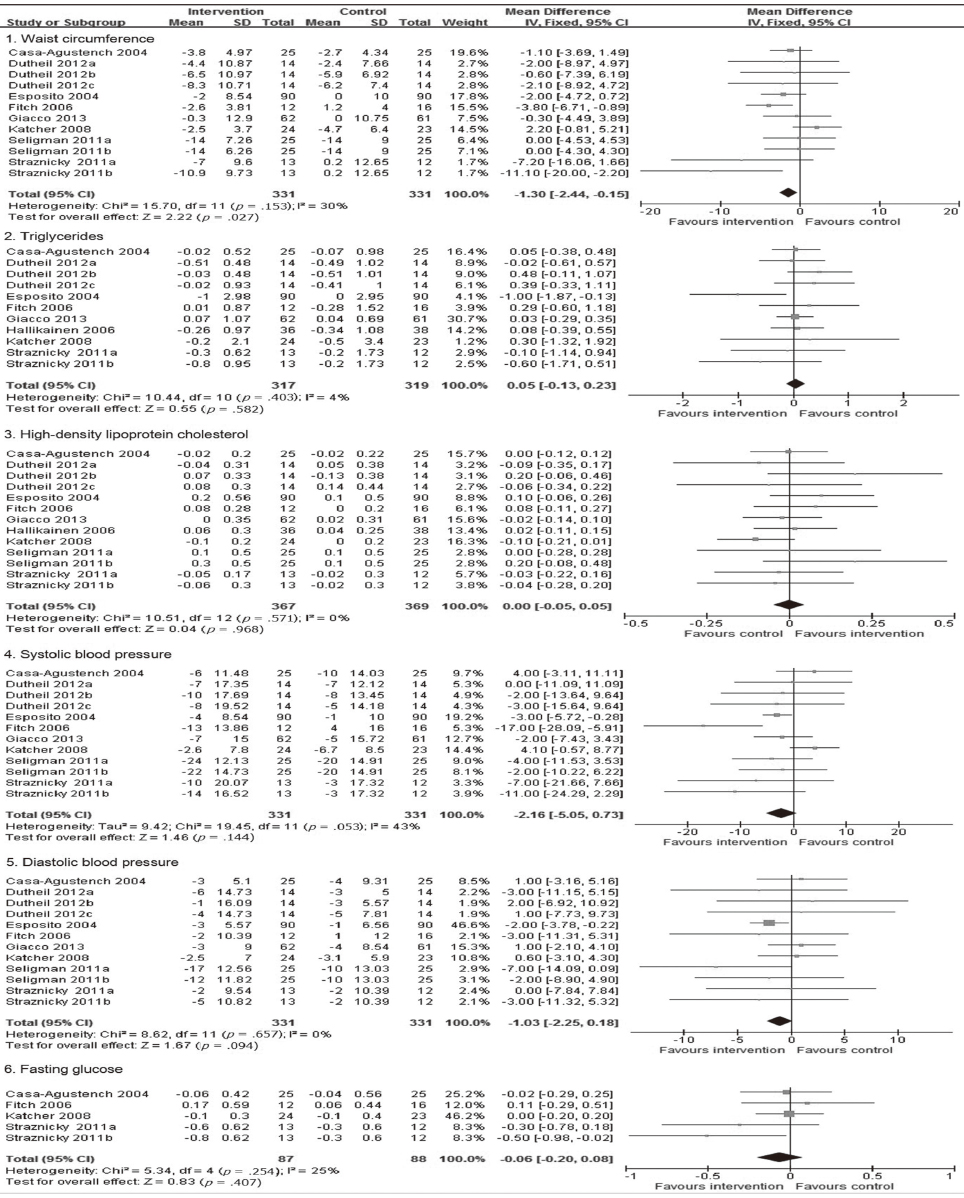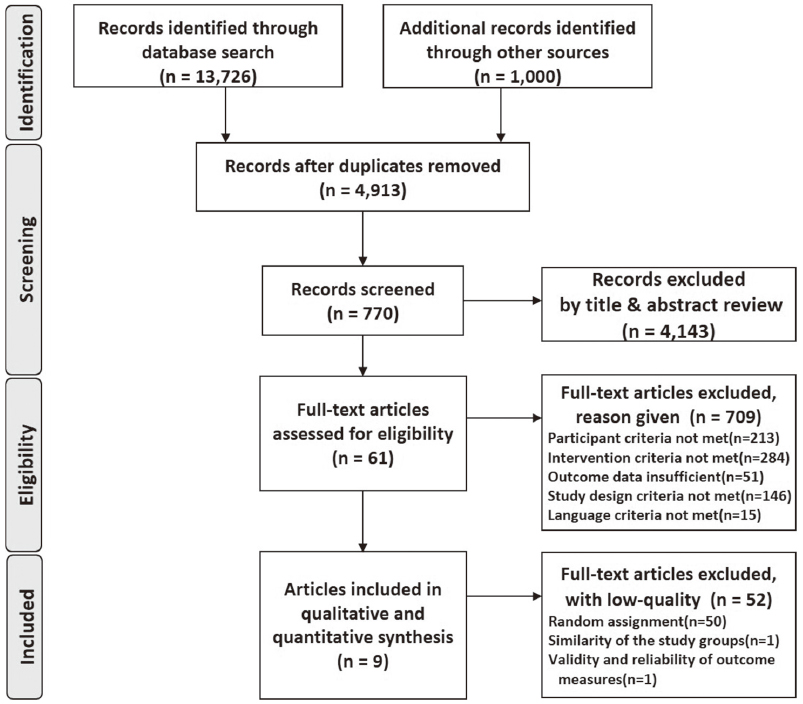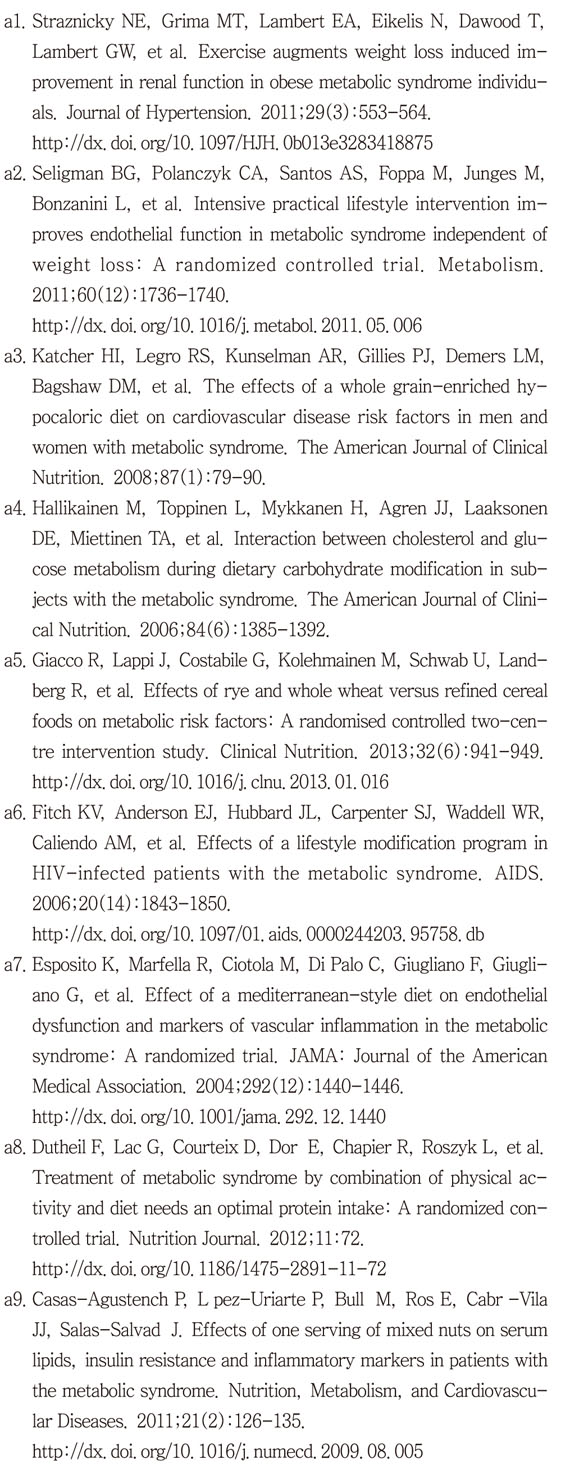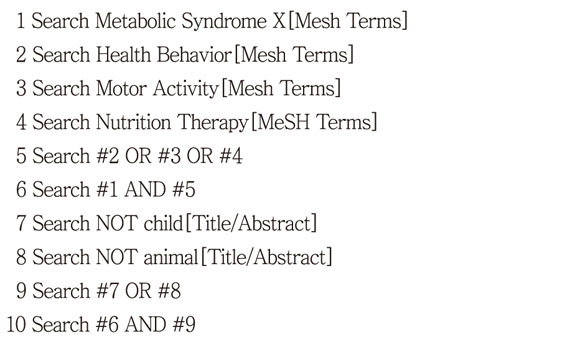Articles
- Page Path
- HOME > J Korean Acad Nurs > Volume 45(4); 2015 > Article
-
Review Article
- Effects of Dietary and Physical Activity Interventions on Metabolic Syndrome: A Meta-analysis
- Guna Lee, Hye-Young Choi, Sook-Ja Yang
-
Journal of Korean Academy of Nursing 2015;45(4):483-494.
DOI: https://doi.org/10.4040/jkan.2015.45.4.483
Published online: August 31, 2015
1Division of Nursing Science, Ewha Womans University, Seoul, Korea.
2Department of Nursing, Tongmyong University, Busan, Korea.
- Address reprint requests to: Yang, Sook-Ja. Helen Hall 203-3, Division of Nursing Science, Ewha Womans University, 52 Ewhayeodae-gil, Seodaemun-gu, Seoul 03760, Korea. Tel: +82-2-3277-4652, Fax: +82-2-3277-2850, yangsj@ewha.ac.kr
© 2015 Korean Society of Nursing Science
This is an Open Access article distributed under the terms of the Creative Commons Attribution NoDerivs License. (http://creativecommons.org/licenses/by-nd/4.0/) If the original work is properly cited and retained without any modification or reproduction, it can be used and re-distributed in any format and medium.
Abstract
-
Purpose
- This study identified effects of dietary and physical activity interventions including dietary interventions or physical activity interventions alone or combined dietary-physical activity interventions to improve symptoms in metabolic syndrome including abdominal obesity, high triglycerides, low high density lipoprotein cholesterol, elevated blood pressure, and elevated fasting glucose through meta-analysis.
-
Methods
- Articles on metabolic syndrome X published from 1988 to 2013 were searched through electronic databases, Google Scholar, and reference reviews. Methodological quality was assessed by the checklist, SIGN (Scottish Intercollegiate Guidelines Network).
-
Results
- In the meta-analysis, there were 9 articles reporting 13 interventions with 736 participants. Using random effect models, the dietary and/or physical activity interventions showed a lower mean difference in waist circumference ( - 1.30 cm, 95% CI: - 2.44~ - 0.15, p =.027). The combined dietary-physical activity interventions showed a lower mean difference in waist circumference ( - 2.77 cm, 95% CI: - 4.77~ - 0.76, p =.007) and systolic blood pressure ( - 5.44 mmHg, 95% CI: - 10.76~ - 0.12, p =.044). Additionally, interventions of over 24 weeks yielded a lower mean difference in waist circumference ( - 2.78 cm, 95% CI: - 4.69~ - 0.87, p =.004) and diastolic blood pressure ( - 1.93 mmHg, 95% CI: - 3.63~ - 0.22, p =.026).
-
Conclusion
- The findings indicate that dietary and/or physical activity interventions for metabolic syndrome reduce central obesity with no adverse effects. This finding provides objective evidences for dietary and physical activity management on metabolic syndrome as an efficient intervention.
- 1. National Cholesterol Education Program (NCEP) Expert Panel on Detection, Evaluation, and Treatment of High Blood Cholesterol in Adults (Adult Treatment Panel III). Third report of the national cholesterol education program (NCEP) Expert panel on detection, evaluation, and treatment of high blood cholesterol in adults (Adult Treatment Panel III) final report. Circulation. 2002;106(25):3143–3421.ArticlePubMed
- 2. International Diabetes Federation. The IDF consensus worldwide definition of the metabolic syndrome [Internet]. Brussels, BE, Author. 2006;cited 2014 October 30. Available from: www.idf.org/webdata/docs/MetS_def_update2006.pdf.
- 3. Alberti KG, Zimmet PZ. Definition, diagnosis and classification of diabetes mellitus and its complications. Part 1: Diagnosis and classification of diabetes mellitus provisional report of a WHO consultation. Diabet Med. 1998;15(7):539–553. ArticlePubMed
- 4. Grundy SM. Metabolic syndrome pandemic. Arterioscler Thromb Vasc Biol. 2008;28(4):629–636. ArticlePubMed
- 5. Kim E, Oh SW. Gender differences in the association of occupation with metabolic syndrome in Korean adults. Korean J Obes. 2012;21(2):108–114. Article
- 6. Gami AS, Witt BJ, Howard DE, Erwin PJ, Gami LA, Somers VK, et al. Metabolic syndrome and risk of incident cardiovascular events and death: A systematic review and meta-analysis of longitudinal studies. J Am Coll Cardiol. 2007;49(4):403–414. PubMed
- 7. Kim MK, Park JH. Metabolic syndrome. J Korean Med Assoc. 2012;55(10):1005–1013. Article
- 8. Kelley DE, Wing R, Buonocore C, Sturis J, Polonsky K, Fitzsimmons M. Relative effects of calorie restriction and weight loss in noninsulin-dependent diabetes mellitus. J Clin Endocrinol Metab. 1993;77(5):1287–1293. ArticlePubMed
- 9. Pitsavos C, Panagiotakos D, Weinem M, Stefanadis C. Diet, exercise and the metabolic syndrome. Rev Diabet Stud. 2006;3(3):118–126. ArticlePubMedPMC
- 10. Jenkins DJ, Kendall CW, Augustin LS, Franceschi S, Hamidi M, Marchie A, et al. Glycemic index: overview of implications in health and disease. Am J Clin Nutr. 2002;76(1):266S–273S.ArticlePubMed
- 11. Kastorini CM, Milionis HJ, Esposito K, Giugliano D, Goudevenos JA, Panagiotakos DB. The effect of mediterranean diet on metabolic syndrome and its components: A meta-analysis of 50 studies and 534,906 individuals. J Am Coll Cardiol. 2011;57(11):1299–1313. PubMed
- 12. Blanco Mejia S, Kendall CW, Viguiliouk E, Augustin LS, Ha V, Cozma AI, et al. Effect of tree nuts on metabolic syndrome criteria: A systematic review and meta-analysis of randomised controlled trials. BMJ Open. 2014;4(7):e004660ArticlePubMedPMC
- 13. Jansen S, Lopez-Miranda J, Salas J, Castro P, Paniagua JA, Lopez-Segura F, et al. Plasma lipid response to hypolipidemic diets in young healthy non-obese men varies with body mass index. J Nutr. 1998;128(7):1144–1149.ArticlePubMed
- 14. Schwingshackl L, Dias S, Strasser B, Hoffmann G. Impact of different training modalities on anthropometric and metabolic characteristics in overweight/obese subjects: A systematic review and network meta-analysis. PLoS One. 2013;8(12):e82853ArticlePubMedPMC
- 15. Dunkley AJ, Charles K, Gray LJ, Camosso-Stefinovic J, Davies MJ, Khunti K. Effectiveness of interventions for reducing diabetes and cardiovascular disease risk in people with metabolic syndrome: Systematic review and mixed treatment comparison meta-analysis. Diabetes Obes Metab. 2012;14(7):616–625. ArticlePubMed
- 16. Higgins JPT, Green S. In: Cochrane handbook for systematic reviews of interventions: Version 5.1.0 [Internet]. London, UK, The Cochrane Collaboration. 2011;cited 2014 September 5. Available from: www.cochrane-handbook.org.
- 17. Reaven GM. Banting lecture 1988. Role of insulin resistance in human disease. Diabetes. 1988;37(12):1595–1607.ArticlePubMed
- 18. U.S. National Library of Medicine. MeSH: Motor activity [Internet]. Bethesda, MD, Author. 1968;cited 2014 October 30. Available from: www.ncbi.nlm.nih.gov/mesh/?term=motor+activity.
- 19. U.S. National Library of Medicine. MeSH: Nutrition therapy [Internet]. Bethesda, MD, Author. 2004;cited 2014 October 30. Available from: www.ncbi.nlm.nih.gov/mesh/68044623.
- 20. Moher D, Liberati A, Tetzlaff J, Altman DG. Preferred reporting items for systematic reviews and meta-analyses: The PRISMA statement. PLoS Med. 2009;6(7):e1000097ArticlePubMedPMC
- 21. Scottish Intercollegiate Guidelines Network. SIGN 50: A guideline developer's handbook [Internet]. Edinburgh, UK, Author. 2011;cited 2014 October 30. Available from: www.sign.ac.uk/guidelines/fulltext/50/index.html.
- 22. Straznicky NE, Grima MT, Lambert EA, Eikelis N, Dawood T, Lambert GW, et al. Exercise augments weight loss induced improvement in renal function in obese metabolic syndrome individuals. J Hypertens. 2011;29(3):553–564. ArticlePubMed
- 23. Seligman BG, Polanczyk CA, Santos AS, Foppa M, Junges M, Bonzanini L, et al. Intensive practical lifestyle intervention improves endothelial function in metabolic syndrome independent of weight loss: A randomized controlled trial. Metabolism. 2011;60(12):1736–1740. ArticlePubMed
- 24. Dutheil F, Lac G, Courteix D, Dore E, Chapier R, Roszyk L, et al. Treatment of metabolic syndrome by combination of physical activity and diet needs an optimal protein intake: A randomized controlled trial. Nutr J. 2012;11:72ArticlePubMedPMCPDF
- 25. Katcher HI, Legro RS, Kunselman AR, Gillies PJ, Demers LM, Bagshaw DM, et al. The effects of a whole grain-enriched hypocaloric diet on cardiovascular disease risk factors in men and women with metabolic syndrome. Am J Clin Nutr. 2008;87(1):79–90.ArticlePubMed
- 26. Giacco R, Lappi J, Costabile G, Kolehmainen M, Schwab U, Landberg R, et al. Effects of rye and whole wheat versus refined cereal foods on metabolic risk factors: A randomised controlled two-centre intervention study. Clin Nutr. 2013;32(6):941–949. ArticlePubMed
- 27. Hallikainen M, Toppinen L, Mykkanen H, Agren JJ, Laaksonen DE, Miettinen TA, et al. Interaction between cholesterol and glucose metabolism during dietary carbohydrate modification in subjects with the metabolic syndrome. Am J Clin Nutr. 2006;84(6):1385–1392.ArticlePubMed
- 28. Fitch KV, Anderson EJ, Hubbard JL, Carpenter SJ, Waddell WR, Caliendo AM, et al. Effects of a lifestyle modification program in HIV-infected patients with the metabolic syndrome. AIDS. 2006;20(14):1843–1850. ArticlePubMed
- 29. Esposito K, Marfella R, Ciotola M, Di Palo C, Giugliano F, Giugliano G, et al. Effect of a mediterranean-style diet on endothelial dysfunction and markers of vascular inflammation in the metabolic syndrome: A randomized trial. JAMA. 2004;292(12):1440–1446. ArticlePubMed
- 30. Casas-Agustench P, López-Uriarte P, Bulló M, Ros E, Cabré-Vila JJ, Salas-Salvadó J. Effects of one serving of mixed nuts on serum lipids, insulin resistance and inflammatory markers in patients with the metabolic syndrome. Nutr Metab Cardiovasc Dis. 2011;21(2):126–135. ArticlePubMed
REFERENCES
Appendix
Forest plot of the effect of dietary and/or physical activity interventions and funnel plot of the effect sizes by standard error on metabolic syndrome criteria.

Characteristics of Studies Included in the Meta-analysis

*The data was reported not considering the drop out of 3 participants from the study; †The number indicates participants' baseline mean of outcome items; Exp.=Experimental group; Cont.=Control group; Mets.=Metabolic syndrome; WC=Waist circumference; TG=Triglycerides; HDL=High-density lipoprotein cholesterol; SBP=Systolic blood pressure; DBP=Diastolic blood pressure; FG=Fasting glucose; NR=Not reported; NCEP=National cholesterol education program adult treatment panel III; IDF=International Diabetes Federation; D=Dietary intervention; P=Physical activity intervention; + =Statistically significant difference between experimental group and control group; - =No significant difference between experimental group and control group; NA=Not applicable.
Quality Assessment of Studies Included in the Meta-analysis

*Indicates that the factor was ignored or not mentioned in this study design; †Indicates that the factor was reported in this study but in insufficient detail to allow assessment; ‡Indicates that the factor was not applicable in this study design; + +All or most of the criteria have been fulfilled: USA.
Subgroup Analysis of Studies Included in the Meta-analysis

*Outcomes are presented as mean difference between intervention groups; †Number of dietary intervention studies; ‡Number of physical activity intervention studies; §Studies with a<24 week intervention period; ∥Studies with an=24 week intervention period; WC=Waist circumference; TG=Triglycerides; HDL=High-density lipoprotein cholesterol; SBP=Systolic blood pressure; DBP=Diastolic blood pressure; FG=Fasting glucose; CI=Confidence interval; D=Dietary intervention; P=Physical activity intervention.
Figure & Data
REFERENCES
Citations

- Scoping review of research trends in genetic factors related to metabolic syndrome in Koreans: using the data from Korean Genome and Epidemiology Study (KoGES)
Minyeong Kim, Subin Kim, Dayeon Shin
Journal of Nutrition and Health.2025; 58(1): 131. CrossRef - Diyabet Riski, Aktivite Düzeyleri ile Akdeniz Tipi Beslenme Davranışları İlişkisi
İbrahim Topuz, Sercan Gümüş, Sebahat Gözüm
Etkili Hemşirelik Dergisi.2025; 18(2): 193. CrossRef - Immune Microenvironment Dysregulation: A Contributing Factor to Obesity-Associated Male Infertility
Rui Feng, Dexin Cheng, Wei Zhang, Jiayun Zhang, Sixiang Chen, Yan Xia
Biomedicines.2025; 13(6): 1314. CrossRef - Development and Evaluation of a Blended Self-Management Program for Metabolic Syndrome in Patients With Rheumatic Diseases
BoAe Im, HyunSoo Oh, SooHyun Kim, HyeSun Jeong, WhaSook Seo
Health Education & Behavior.2024; 51(4): 625. CrossRef - Development and effectiveness of a mobile-based autonomy support program for the prevention of metabolic syndrome in middle-aged women
Miseon Seo, Eun-Young Jun, Hyunjin Oh
Frontiers in Public Health.2024;[Epub] CrossRef - Psychosocial Determinants of Recommended Lifestyle Behaviors among Hypertensive Patients: An Integrative Literature Review
Wachira Suriyawong, Tsui-Sui Annie Kao, Lorraine B. Robbins, Jiying Ling, Leapetswe Malete
Western Journal of Nursing Research.2023; 45(5): 455. CrossRef - 노인 대사증후군에 효과적인 중재: 체계적 문헌고찰과 메타분석
서현 이, 슬 구, 유미 서, 선화 반
Public Health Weekly Report.2023; 16(48): 1633. CrossRef - Association between green tea consumption and metabolic syndrome among Korean adults: results from the Health Examinees study
Hyeonjin Cho, Sunwoo Han, Jiwon Jeong, Hyein Jung, Sangah Shin
Journal of Nutrition and Health.2023; 56(1): 70. CrossRef - Metabolic syndrome and erectile dysfunction: a systematic review and meta-analysis study
D. G. Corona, W. Vena, A. Pizzocaro, G. Rastrelli, C. Sparano, A. Sforza, L. Vignozzi, M. Maggi
Journal of Endocrinological Investigation.2023; 46(11): 2195. CrossRef - Determination of Factors Inhibiting the Physıcal Activity Status of Nursing Students in the Covid-19 Pandemic
Tuba Bülbül, Betül Tosun, Ezgi Dirgar
International Journal of Disabilities Sports and Health Sciences.2022; 5(1): 30. CrossRef - Impact of motivational interviewing as a follow-up to an exercise intervention among women with or at risk for metabolic syndrome: A randomized controlled trial
Kameron B Suire, Ashley Peart, Jan Kavookjian, Danielle D Wadsworth
SAGE Open Medicine.2022;[Epub] CrossRef - Peripheral and cognitive benefits of physical exercise in a mouse model of midlife metabolic syndrome
Farida El Gaamouch, Hsiao-yun Lin, Qian Wang, Wei Zhao, Jiangping Pan, Kalena Liu, Jean Wong, Clark Wu, Chongzhen Yuan, Haoxiang Cheng, Weiping Qin, Ke Hao, Bin Zhang, Jun Wang
Scientific Reports.2022;[Epub] CrossRef - Gender Differences of Health Behaviors in the Risk of Metabolic Syndrome for Middle-Aged Adults: A National Cross-Sectional Study in South Korea
Jaehee Yoon, Jeewuan Kim, Heesook Son
International Journal of Environmental Research and Public Health.2021; 18(7): 3699. CrossRef - A Technology-Mediated Interventional Approach to the Prevention of Metabolic Syndrome: A Systematic Review and Meta-Analysis
Gaeun Kim, Ji-Soo Lee, Soo-Kyoung Lee
International Journal of Environmental Research and Public Health.2021; 18(2): 512. CrossRef - Metabolic Syndrome and Functional Fitness Abilities
Laura Gallardo-Alfaro, Maria del Mar Bibiloni, Emma Argelich, Escarlata Angullo-Martinez, Cristina Bouzas, Josep A. Tur
Journal of Clinical Medicine.2021; 10(24): 5840. CrossRef - Effects of BeHaS Program on Health Behavior, Physiologic Index and Self-Esteem of the Elderly Living Alone with Metabolic Syndrome Based on Community Based Participatory Research
Jong Im Kim, Sun Ae Kim, Keumok Park, Jiyoung Kim, Lina Lee, Si Wan Choi, Bon Jeong Ku
Journal of Korean Academy of Nursing.2020; 50(4): 571. CrossRef - Dietary Fat Intake and Metabolic Syndrome in Older Adults
Alicia Julibert, Maria del Mar Bibiloni, David Mateos, Escarlata Angullo, Josep A. Tur
Nutrients.2019; 11(8): 1901. CrossRef - Metabolic fitness in relation to genetic variation and leukocyte DNA methylation
M. Caspers, S. Blocquiaux, R. Charlier, J. Lefevre, K. De Bock, M. Thomis
Physiological Genomics.2019; 51(1): 12. CrossRef - Effects of a Self-Care Reinforcement Program for Socially Vulnerable Elderly Women with Metabolic Syndrome in Korea
Mikyung Park, Kiwol Sung
Journal of Korean Academy of Community Health Nursing.2019; 30(3): 271. CrossRef - Flavonoids and Insulin-Resistance: From Molecular Evidences to Clinical Trials
Benedetta Russo, Fabiana Picconi, Ilaria Malandrucco, Simona Frontoni
International Journal of Molecular Sciences.2019; 20(9): 2061. CrossRef - Metabolic Syndrome Status of Chinese Workers and Their Physical Profiles, Lifestyle Scores, and Nutrient Intakes
Chao Wang, Hokyung Ryu
Korean Journal of Community Nutrition.2017; 22(1): 63. CrossRef - Physical activity, mediating factors and risk of colon cancer: insights into adiposity and circulating biomarkers from the EPIC cohort
Krasimira Aleksandrova, Mazda Jenab, Michael Leitzmann, Bas Bueno-de-Mesquita, Rudolf Kaaks, Antonia Trichopoulou, Christina Bamia, Pagona Lagiou, Sabina Rinaldi, Heinz Freisling, Marion Carayol, Tobias Pischon, Dagmar Drogan, Elisabete Weiderpass, Paula
International Journal of Epidemiology.2017; 46(6): 1823. CrossRef - Association between siesta (daytime sleep), dietary patterns and the presence of metabolic syndrome in elderly living in Mediterranean area (MEDIS study): The moderating effect of gender
E.N. Georgousopoulou, N. Naumovski, D.D. Mellor, S. Tyrovolas, S. Piscopo, G. Valacchi, N. Tsakountakis, A. Zeimbekis, V. Bountziouka, E. Gotsis, G. Metallinos, D. Tyrovola, J. Kellett, A. Foscolou, J.-A. Tur, A.-L. Matalas, C. Lionis, E. Polychronopoulos
The Journal of nutrition, health and aging.2017; 21(10): 1118. CrossRef - metabolic syndrome: some results and prospects for solving the problem
Чу, Syaoyan Chu, Киргизова, Oksana Kirgizova
Бюллетень Восточно-Сибирского научного центра Сибирского отделения Российской академии медицинских наук.2016; 1(5): 187. CrossRef - Prevalence of Central Obesity among Adults with Normal BMI and Its Association with Metabolic Diseases in Northeast China
Peng Zhang, Rui Wang, Chunshi Gao, Lingling Jiang, Xin Lv, Yuanyuan Song, Bo Li, Pratibha V. Nerurkar
PLOS ONE.2016; 11(7): e0160402. CrossRef


Figure 1
Figure 2
Characteristics of Studies Included in the Meta-analysis
*The data was reported not considering the drop out of 3 participants from the study; †The number indicates participants' baseline mean of outcome items; Exp.=Experimental group; Cont.=Control group; Mets.=Metabolic syndrome; WC=Waist circumference; TG=Triglycerides; HDL=High-density lipoprotein cholesterol; SBP=Systolic blood pressure; DBP=Diastolic blood pressure; FG=Fasting glucose; NR=Not reported; NCEP=National cholesterol education program adult treatment panel III; IDF=International Diabetes Federation; D=Dietary intervention; P=Physical activity intervention; + =Statistically significant difference between experimental group and control group; - =No significant difference between experimental group and control group; NA=Not applicable.
Quality Assessment of Studies Included in the Meta-analysis
*Indicates that the factor was ignored or not mentioned in this study design; †Indicates that the factor was reported in this study but in insufficient detail to allow assessment; ‡Indicates that the factor was not applicable in this study design; + +All or most of the criteria have been fulfilled: USA.
Subgroup Analysis of Studies Included in the Meta-analysis
*Outcomes are presented as mean difference between intervention groups; †Number of dietary intervention studies; ‡Number of physical activity intervention studies; §Studies with a<24 week intervention period; ∥Studies with an=24 week intervention period; WC=Waist circumference; TG=Triglycerides; HDL=High-density lipoprotein cholesterol; SBP=Systolic blood pressure; DBP=Diastolic blood pressure; FG=Fasting glucose; CI=Confidence interval; D=Dietary intervention; P=Physical activity intervention.
*The data was reported not considering the drop out of 3 participants from the study; †The number indicates participants' baseline mean of outcome items; Exp.=Experimental group; Cont.=Control group; Mets.=Metabolic syndrome; WC=Waist circumference; TG=Triglycerides; HDL=High-density lipoprotein cholesterol; SBP=Systolic blood pressure; DBP=Diastolic blood pressure; FG=Fasting glucose; NR=Not reported; NCEP=National cholesterol education program adult treatment panel III; IDF=International Diabetes Federation; D=Dietary intervention; P=Physical activity intervention; + =Statistically significant difference between experimental group and control group; - =No significant difference between experimental group and control group; NA=Not applicable.
*Indicates that the factor was ignored or not mentioned in this study design; †Indicates that the factor was reported in this study but in insufficient detail to allow assessment; ‡Indicates that the factor was not applicable in this study design; + +All or most of the criteria have been fulfilled: USA.
*Outcomes are presented as mean difference between intervention groups; †Number of dietary intervention studies; ‡Number of physical activity intervention studies; §Studies with a<24 week intervention period; ∥Studies with an=24 week intervention period; WC=Waist circumference; TG=Triglycerides; HDL=High-density lipoprotein cholesterol; SBP=Systolic blood pressure; DBP=Diastolic blood pressure; FG=Fasting glucose; CI=Confidence interval; D=Dietary intervention; P=Physical activity intervention.
 KSNS
KSNS
 E-SUBMISSION
E-SUBMISSION



 Cite
Cite

